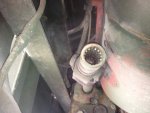Rebar
Member
- 52
- 0
- 6
- Location
- St. Louis/Missouri
winch drive shaft "retubing"--"dead-spline" in line with ear or 90 degree offset?
I am in the process of having the winch drive shaft "re-tubed" for my M817. I took the shaft in and the guy wants to know whether the "dead-spline" of the receiver is "in line with the universal ear" or 90 degrees offset. Well the truck is at the farm but I did happen to take a picture of it (attached) and it looks to me that the "dead-spline" is neither in line with the ear nor 90 degrees offset. First of all, I am assuming that this is critical to re-tubing the drive shaft--he seemed to think so.

Second of all, he says the shaft is way to long to be just 2 inches in diameter. He wants to put a 3 inch tube on there. It looks like there is clearance under the truck, but I thought I would check with the collective brain power of this website. I would hate to have it re-tubed only to find it won't fit. I cannot find a reference to any of this in the TM's.
I would appreciate any help that you can offer.
Rebar
I am in the process of having the winch drive shaft "re-tubed" for my M817. I took the shaft in and the guy wants to know whether the "dead-spline" of the receiver is "in line with the universal ear" or 90 degrees offset. Well the truck is at the farm but I did happen to take a picture of it (attached) and it looks to me that the "dead-spline" is neither in line with the ear nor 90 degrees offset. First of all, I am assuming that this is critical to re-tubing the drive shaft--he seemed to think so.

Second of all, he says the shaft is way to long to be just 2 inches in diameter. He wants to put a 3 inch tube on there. It looks like there is clearance under the truck, but I thought I would check with the collective brain power of this website. I would hate to have it re-tubed only to find it won't fit. I cannot find a reference to any of this in the TM's.
I would appreciate any help that you can offer.
Rebar


